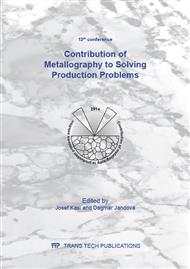p.131
p.141
p.147
p.153
p.162
p.173
p.180
p.188
p.195
Material Degradation of Steam Pipe Elbow after Long-Term Exposure
Abstract:
Routine non-destructive examination of the steam pipe elbow after more than 240 000 hours of operation at elevated temperature revealed the extensive creep damage on the outer surface of the pipe elbow. Complex metallographic analysis made in this area confirmed creep damage as well as the non-uniform nature of the cavitation. The density of cavities continuously decreased from the outer pipe surface towards the inner surface, but also its density rapidly waned beyond the damaged area in both directions, along the circumference as well as the length of the elbow. The actual extent of the material degradation was then evaluated by testing of mechanical properties, Charpy-V and fracture toughness testing and the results were used in calculation of the residual life of the pipe elbow. It was shown that although the creep damage was perhaps one of the worst detected in Czech Republic, the cracks in the pipe elbow would spread by the stable growth until the half of the pipe wall thickness. This result thus confirms the possibility of creep life extension far beyond the limit criteria used so far.
Info:
Periodical:
Pages:
162-169
Citation:
Online since:
May 2015
Authors:
Price:
Сopyright:
© 2015 Trans Tech Publications Ltd. All Rights Reserved
Share:
Citation:


